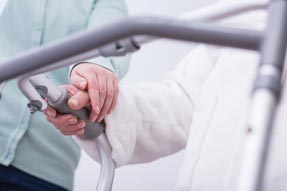A better signal-to-noise ratio for guidelines
It takes about 15 years to broadly implement clinical guidelines into practice. Physicians and scientists are working to shorten this lag and strengthen the connection by examining how guidelines are developed, delivered, and adopted.
Clinical guidelines help physicians put evidence into practice, at least in theory. But this knowledge pipeline doesn't flow quickly.
“It takes about 15 years between us knowing that something works and getting it broadly into practice,” said Greg Randolph, MD, MPH, a professor of pediatrics and public health at the University of North Carolina and CEO of Population Health Improvement Partners. “It's a little bit haphazard in how it happens.”

In the era of quality improvement and translational science, guidelines are an important link between bench and bedside. Though turnaround times can vary based on circumstances, most experts agree that lags exist between the time useful guidelines are published and when they appear in day-to-day patient care.
Physicians and scientists are working to shorten these lags and strengthen this connection by examining how clinical practice guidelines are developed, delivered, and adopted.
Part of the solution lies in technology. Another part is found in physician learning and practice, that is, determining how best to drink a torrent of information from the modern fire hose of peer-reviewed literature, then apply those lessons to the real world.
Still another factor involves the guidelines themselves, which for years have been created and disseminated under nebulous, mutable circumstances. Conflicts of interest are not uncommon and are not always properly disclosed or managed.
“There is a lack of transparency, and major variation when it comes to guidelines,” said Amir Qaseem, MD, PhD, MHA, FACP, ACP's Vice President of Clinical Policy and a board of trustees member with Guidelines International Network, a group dedicated to strengthening clinical guidelines and guideline development.
In short, clinical guidelines are not always the perfect guides—and could benefit, experts contend, from new guidelines of their own. For example, Dr. Qaseem said, Guidelines International Network and Academy of Medicine have standards on developing guidelines.
Apples and oranges
Even the definition of clinical practice guidelines—generally, systematically developed statements to assist practitioners and patients in making decisions about appropriate health care in specific circumstances—is uncertain. There is no universal evidence threshold, formal or otherwise, to meet before guidelines can be developed. Different organizations and societies create guidelines for different reasons and under different standards.
As a result, quantity is high and quality is uneven.
“All guidelines are not created equal,” said Robert Centor, MD, MACP, regional dean of the University of Alabama School of Medicine Huntsville Regional Medical Campus in Alabama and a researcher in medical decision making who comments frequently on guidelines on his popular Medrants blog. “There has been such a proliferation of guidelines that it has become about sorting out the wheat from the chaff to figure out what is important. Where we haven't done a good job is prioritization.”
It's more than a signal-to-noise problem. Many organizations, researchers said, release guidelines to help advance agendas or policy positions. Sometimes, these kinds of guidelines obfuscate or even undercut guidelines based solely on solid science.
“There is a competing priority in that a lot of guiding statements and policy statements that come out have clinical recommendations in them,” said Emily Vander Schaaf, MD, MPH, a primary care research fellow at the University of North Carolina School of Medicine's pediatrics department and fellow at Population Health Improvement Partners. “There's a much weaker or no evidence base to support them in this case. People look at things as guidelines when they're not. Lower-quality recommendations get thrown into the mix.”
All too often, busy physicians react by tuning out guidelines altogether.
“Everyone puts these out now, and a lot of the time they overstate the evidence,” said Lee Green, MD, MPH, a health services researcher and professor and chair of family medicine at the University of Alberta Faculty of Medicine and Dentistry in Edmonton, Alberta, Canada. “Physicians have become skeptical, unfortunately, and with good reason ... They're throwing out the baby with the bathwater.”
The how and who of development
Committees that perform systematic reviews and develop clinical practice guidelines—typically comprising physicians and researchers with expertise in a relevant clinical area who serve for predefined periods of time—are focused on improvement.
Physicians are increasingly looking to groups they trust to not only develop guidelines but to help identify guidelines with sound evidence bases and actionable recommendations.
“There are so many [guidelines] that they're looking to reputable groups to curate guidelines,” said Mary Forciea, MD, MACP, chair of the ACP Clinical Guidelines Committee. “Those tend to be more influential.”
According to Dr. Forciea, guideline developers are working more closely and frequently with those who formulate performance measures to ensure that one side informs the other. What's more, in 2011, an Institute of Medicine report titled “Clinical Practice Guidelines We Can Trust” recommended, among other things, that guideline development groups eliminate or minimize conflicts of interest in their members and seek input from consumers and other users.
“Committees can include patients and patient groups in guideline formulation so it's not just providers making decisions in a paternalistic way,” Dr. Forciea said. “Guidelines that are used by patients are an area we talk about, creating a version of the guidelines that can be understood and accessed by patients online.”
A system of evaluating and “grading” guidelines also is gaining traction. Known as GRADE (Grading of Recommendations Assessment, Development and Evaluation), the system was developed in 2004 and assigns letter grades based on the quality of evidence presented, risk of bias, precision of estimates, consistency of the results, and directness of evidence. Various government agencies and specialty societies have adopted GRADE for use in assessing guidelines.
Though a formal system like GRADE is useful, the key for guideline developers and users, Dr. Qaseem said, is transparency. A lack of transparency, he noted, could be a red flag for low quality.
“Developers should describe how the guidelines were developed,” Dr. Qaseem said. “Was there a diverse group of stakeholders, including clinicians and patients? How were the decisions made? How did the group reach consensus? How were financial and nonfinancial conflicts disclosed and managed? This should all be very clearly spelled out.”
Role of technology
As it stands, journal reports and professional development activities are the main dissemination vehicles for clinical practice guidelines. But they may not be enough, at least by themselves, to spur meaningful action.
“It's hard to change ingrained behaviors,” Dr. Forciea said. “Many things factor into a physician's practice style. All guideline-producing organizations are experimenting with all sorts of ways to do this.”
Existing and emerging technologies can help, even if they are not a panacea. Smartphone apps can help put guidelines in front of care teams. Electronic health records (EHRs) are another key tool.
According to Drs. Vander Schaaf and Randolph, some emerging EHR functionalities that could help include clinical decision support mechanisms, stronger search functions, and benchmarks of outcomes data against national standards.
At this point, however, EHR technologies must evolve before these capabilities are widespread and optimized.
“It would be nice if a computer knew context,” said David Bates, MD, MACP, senior vice president and chief innovation officer at Brigham and Women's Hospital in Boston. “If I'm seeing a patient who has vertigo, the computer doesn't know the clinical situation ... It's something EHR vendors need to address. You can make it more clear what the clinical situation is in real time [by] collecting patient complaints in coded form before the doctor sees them.”
Changing the physician learner
As beneficial as it can be, technology alone is not the answer. The most important means of finding and leveraging good guidelines is the physician.
But for all their training, many doctors miss out on learning a critical topic: learning itself.
“The problem comes down to the nature of knowledge,” Dr. Green said. “In order to work, guidelines have to be transferred from academic understanding, or declarative knowledge, into what we actually do, or procedural knowledge. That transition is not trivial.”
As an example, Dr. Green cites the airline industry, a longtime model of efficient training and operation. If a new way of landing a jet becomes available, for instance, an airline may take 20% of its pilots out of circulation for training in a simulator and then on supervised test flights. Once they are appropriately competent, pilots return to the flight line, with the next 20% of pilots then undergoing the same process.
“We have nothing like that in medicine,” Dr. Green said. “What we don't have is a systematic approach to knowledge management.”
Some larger health systems have established these kinds of techniques, but they remain uncommon, especially in smaller practices. That's not to say, however, that there aren't ways to do it.
“On an individual level, it's pretty hard,” Dr. Green said. “Reminder tricks can work. Run through the schedule in advance, and tack a reminder on to each patient.”
Tools like medical case simulations and advanced maintenance of certification and proficiency programs also help physicians to, as Dr. Green said, “work with information and reduce the noise.”
Medical education is undergoing well-documented changes that include a move from traditional didactic formats to more interactive approaches. Knowledge management is part of this transformation. A more robust and deliberate system of feedback and discussion can enhance knowledge uptake at the undergraduate, graduate, and continuing education levels, Dr. Green said.
Given their important role linking science with practice, it benefits clinicians and patients to have the strongest possible guidelines—and to know how to drink from the informational fire hose.
“There isn't a direct connection between clinical guidelines and the end user,” Dr. Green said. “There's no particular mechanism to ... tell the good from the bad. It's not hard, but it does require some critical thinking skills.”




